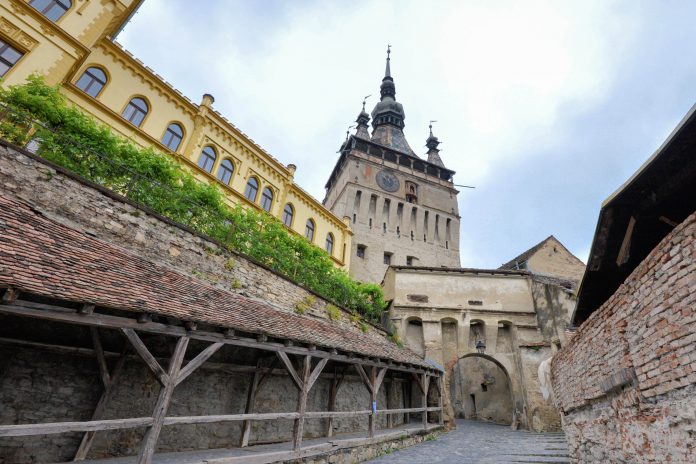Die „bewohnte Burg“, das Stadtzentrum von Sighisoara (Schäßburg), zählt mit ihren verschachtelten Dächern, dem imposanten Stundturm und der unverwechselbaren Bergkirche zu den schönsten mittelalterlichen Vermächtnissen Europas.
Sighisoara, eine kleine Stadt im historischen Teil des legendären Transsylvanien in Rumänien, ist mit ihren Türmchen, krummen Häuschen und verwinkelten Gassen die einzig noch erhaltene und bewohnte mittelalterliche Festung Europas.
In kaum einer anderen Stadt sind die Vermächtnisse von Gotik, Renaissance, Barock und Historismus in derart konzentrierter und ursprünglicher Form zu finden. Man muss sie einfach gesehen haben – deshalb zählt sie zu unseren Top 10 Sehenswürdigkeiten von Rumänien.
Inhaltsverzeichnis
BILDER: Sighisoara
Anreise nach Sighisoara
Die Anfahrt nach Sighisoara kann entweder mit dem Auto oder mit dem Zug erfolgen. Zugverbindungen gibt es von Bukarest, Sibiu, Brasov, oder international von Budapest (Ungarn) und Wien (Österreich).
Sehenswürdigkeiten von Sighisoara
Das gesamte historische Zentrum von Sighisoara wird als „Burg“ bezeichnet. Die Altstadt von Sighisoara zählt seit 1999 als herausragendes Beispiel für eine mittelalterliche Stadt zum Weltkulturerbe der UNESCO. Die Zitadelle von Sighisoara entstand im 12. Jahrhundert durch deutschstämmige rumänische Sachsen auf Geheiß des ungarischen Königs. Noch heute werden die verwinkelten Gassen von Sighisoara von pastellfarbenen Bürgerhäusern gesäumt
Tipp: Sind am Abend die kameraklickenden Tagesbesucher aus Sighisoara wieder abgezogen, kann sich der märchenhafte Charme dieser puppenstubenhaften Altstadt erst so richtig entfalten. Eine Übernachtung in einer der zauberhaften Pensionen hinter historischen Mauern lohnt sich!
Stundturm

Wahrzeichen, wohl auffälligstes Bauwerk und beliebtestes Fotomotiv in der Altstadt von Sighisoara ist der eindrucksvolle Stundturm aus dem späten 14. Jahrhundert. Er stellt heute die Verbindung zwischen Unter- und Oberstadt dar.
Der 64m hohe Turm war bis 1656 Ratssitz der Stadtregierung und damals das Haupttor der Burg. Im fünften und obersten Stock, auf knapp 40 Metern Höhe, diente eine hölzerne Galerie als Ausguck und Feuerwache. Ein Stockwerk darunter befindet sich Rumäniens einzige mechanische Uhr, die dem Stundturm seinen Namen gab.
Sein heutiges Aussehen stammt aus dem 17. Jahrhundert, nachdem er nach einem Großbrand renoviert wurde. Nach wie vor zeichnen ihn die vier Türmchen an den Ecken des Daches als Zeichen der Blutgerichtsbarkeit aus.
Seit 1898 befindet sich innerhalb seiner über 2 Meter dicken Steinmauern das Museum der Zünfte. An diese erinnern auch weitere fünf der einst vierzehn Türme der Stadtmauer, die im Mittelalter die Oberstadt von Sighisoara befestigte (Fleischer- Kürschner-, Schneider-, Schuster-, Zinngießerturm).
Klosterkirche

Die Klosterkirche ist hinter dem Stundturm auf der rechten Seite zu finden. Sie wurde im 13. Jahrhundert von Dominikaner-Mönchen errichtet und war einst mit einem Kloster verbunden, das jedoch Ende des 19. Jahrhunderts zugunsten des Rathauses abgerissen wurde.
Die heutige Kirche stammt aus dem späten 17. Jahrhundert, nachdem ihre Vorgängerin dem Stadtbrand im Jahr 1676 zum Opfer fiel. Bemerkenswert in der Klosterkirche sind die 33 handgeknüpften Teppiche, die dem Orden einst von anatolischen Kaufleuten geschenkt wurden, die barocke Orgel, der barocke Altar und das bronzene Taufbecken aus dem Jahr 1440. Hinter der Kirche tut sich ein hübscher Blick über Sighisoaras Unterstadt auf.
Schäßburger Bergkirche

Die unverwechselbare Schäßburger Bergkirche thront auf dem Gipfel des Schulberges über der Altstadt von Sighisoara und ist heute eher Museum als Kirche. Das befestige Gotteshaus wurde ab 1345 erbaut und zeigt historische Stollentruhen aus dem 16. Jahrhundert sowie einige Altäre aus ehemaligen Kirchen von aufgelassenen Gemeinden in Siebenbürgen-Sachsen.
Bemerkenswert ist außerdem, dass die Schäßburger Bergkirche die einzige Krypta von Siebenbürgen beherbergt, die für Touristen zugänglich ist. Ebenfalls sehenswert ist der angrenzende deutsche Friedhof mit seinen kunstvollen Grabsteinen inmitten sattgrüner Bäume. Vom Burgberg aus fällt der Blick über die verschachtelten Dächer von Schäßburg und Teile der Stadtmauer.
Tipp: Mit einem Kombiticket für die Schäßburger Kirche kann auch die ab 1291 errichtete Klosterkirche des Dominikaner-Ordens neben dem Stundturm besichtigt werden.
Gleich unterhalb der Bergkirche auf dem Schulberg liegt das Gymnasium Josef-Haltrich-Lyzeum, dessen Eingang wie auch die Bergkirche über eine überdachte Treppe mit 100 Stufen erreicht werden kann.
Marktplatz von Sighisoara

Der kopfsteingepflasterte Marktplatz von Sighisoara wird von mehreren sehenswerten Handelshäusern gesäumt, darunter das Haus mit dem Hirschgeweih, das einst der reichen Familie Wenrich und Bacon gehörte und heute in ein lukratives Hotel umfunktioniert wurde, und das Venezianische Haus, so genannt aufgrund seiner auffälligen gotischen Spitzbogenfenster.
Direkt neben dem Haus mit dem Hirschgeweih thront außerdem die evangelische Kirche, die von 1492 bis 1515 als Klosterkirche errichtet wurde. Zu ihren historischen Schätzen gehören Wandmalereien aus ihrer Entstehungszeit, ein Bronze-Taufbecken von 1411, der prachtvolle Barock von Orgel und Altar sowie 35 Orientteppiche, die auf das 16. und 17. Jahrhundert zurückgehen.
Graf Dracula in Sighisoara

Graf Dracula, die Figur aus Bram Stokers Roman, wird wie nahezu in ganz Siebenbürgen auch in Sighisoara vermarktet. Der Legende zufolge soll Vlad III. Drăculea, Sohn von Vlad II. Dracul und Vorbild für Graf Dracula, 1431 in einem Haus in Sighisoara geboren worden sein. „Der Pfähler“ soll anschließend fünf Jahre in der Stadt gewohnt haben.
Zu besichtigen sind allerdings nur zwei Räume über einem Restaurant. Um die Ecke erinnert eine Büste an den „Pfähler“. Neben dem Geburtshaus von Vlad Tepes (Vlad III. Drăculea), wurde ein kleines Waffenmuseum eingerichtet, das mittelalterliche Schwerter, sowie Pfeile und Bögen zeigt.
Tipp: Wenn ihr auf eurer Reise durch Rumänien auf Draculas Spuren wandeln wollt, müsst ihr unbedingt auch „seine Burg“, das Schloss Bran, besuchen.
Veranstaltungen in Sighisoara
Im Sommer locken auch einige Festivals zahlreiche Gäste in die Stadt, zum Beispiel das Mittelalter-Musikfestival am letzten Juli-Wochenende, das jedes Jahr an die 30.000 Touristen nach Sighisoara lockt. Bei dem dreitägigen Festival gibt es neben mittelalterlicher Musik aus Tanz und Theater, Handwerk und Ausstellungen zu bestaunen.
Im August können das akademische Musikfestival mit klassischer Musik im Rathaussaal oder der sonst geschlossenen Synagoge, oder das multi-ethnische Fest ProEtnica besucht werden, auf dem sich alle ethnischen Gruppen Rumäniens treffen und gemeinsam singen, tanzen und feiern.





